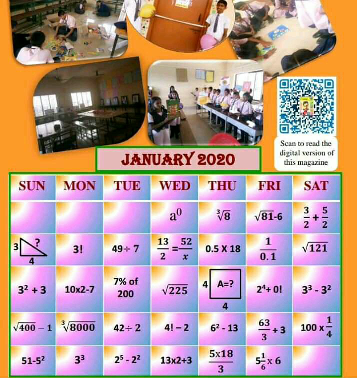
Question and Answers Forum
OthersQuestion and Answers: Page 77



|
Question and Answers Forum |
OthersQuestion and Answers: Page 77 |
| given { ((3^y −1= (6/2^x ))),(((3)^(y/x) = 2 )) :} find (1/x)+(1/y). |
| given a quadratic equation 3x^2 −x+(t^2 −4t+3)=0 has roots sin α and cos α. find the value (√(t^2 −4t+5)) . |

|
| Any reference to a book or video that coould help me solve Differential equations? please help |
| Σ_(r=1) ^∞ (1/r^k ) is divergent for: A. k ≤ 1 B. k > 2 C. k ≤ 2 D. 0 ≤ k < 2 |
| In a ABC triangle the side a=6 and c^2 −b^2 =66. Calculate the projections of sides b and c on a. |

|
| one of the foci of the ellipse (x^2 /9) + (y^2 /4) = 1 is A. (4,0) B. (9,0) C. (5,0) D. ((√5) , 0) |
| A compound pendulum ocsillates through angles θ about its equilibrium position such that 8aθ^2 = 9g cosθ, a>0. its period is A. 2π(√((8a)/(9g))) B. ((3π)/8)(√(a/g)) C. 2π(√((9g)/(8a))) D. ((8π)/3)(√(a/g)) |
| Σ_(k=1) ^(2n) (−1)^k = A. ∞ B. 1 C. −1 D. 0 |
| The eccentricity of the hyperbola (x^2 /(64)) − (y^2 /(36)) = 1 is A. (5/4) B. (3/4) C. (4/5) D. (4/3) |

|
| 3)αparticle of energy 5MeV pass through an ionisation chamber at the rate of 10 pwe second . Assum that all the energy is used in producing ion pairs,calculate the current produced. (35MeV is required for producing an ion pair and e=1.6×10^(-19) C) solution: Energy of α particles=5×10^6 eV Energy required for producing one ion pair=35eV No.of ion pairs produced by one α particle =((5×10^6 )/(35))=1.426×10^5 since 10 particle enter the chamber in one second =1.426×10^5 ×10=1.426×10^6 charge on dach ion=1.6×10^(-19) C Current=(1.426×10^6 )×(1.6×10^(-19) )C/s =2.287×10^(-13) A. |
| var(x) = 2 then var(2x −3)=? E(x) = 2 then E(2x −3) = ? |
| ∫_0 ^3 ∣x^2 −1∣ dx ≡ |
| the maclaurin expansion of ln (3 + 4x) is valid for A) −(3/4) ≤ x< (3/4) B) −(3/4)< x ≤ (3/4) C) −(1/4)< x ≤ (1/4) D) −(3/4)< x < (3/4) |
| prove that: ∫_0 ^1 (1−x^7 )^(1/3) dx=∫_0 ^1 (1−x^3 )^(1/7) dx |
| A uniform ladder of weight W and length 2a rest in limiting equilibrium with one end on a rough horizontal ground and the other end on a rough vertical wall. The coefficient of friction between the ladder and the ground and between the ladder and the wall are respectively μ and λ . If the ladder makes an angle θ with the ground where tan θ = (5/(12)), a) show that 5μ + 6λμ − 6 = 0. b) find the value of λ and μ given that λμ =(1/2). |
| given a sequence defined by {((3n)/(2n+ 5))}_(n=1) ^∞ , does this sequence converge or diverge, explain |
| Hello have nice end of year good bless you all i respond note in y re message becsuse i have so many problemes that mack me feel no pleasur any more to do somthing i think its importante to say it i will back Soon i hop so Sorry for my English |
| prove that 1. Σ_(r=1) ^n r = (1/2)n(n+1) 2. Σ_(r=1) ^n r^2 = (1/6)n(n+1)(2n + 1) 3. Σ_(r=1) ^n r^3 = (1/4)n^2 (n + 1)^2 |
| prove that Σ_(r=1) ^∞ (1/r^2 ) = (π^2 /6) |
| Let P(x) be polynomial in x with integral coefficients. If n is a solution of P(x)≡0(mod n) , and a≡b(mod n), prove that b is also a solution. |
| how do we find ∫_0 ^(π/2) sinh^(−1) x dx and ∫_0 ^(π/2) cosh^(−1) xdx |
| hello solve in R tanx>(√3) please explain me if possible. |